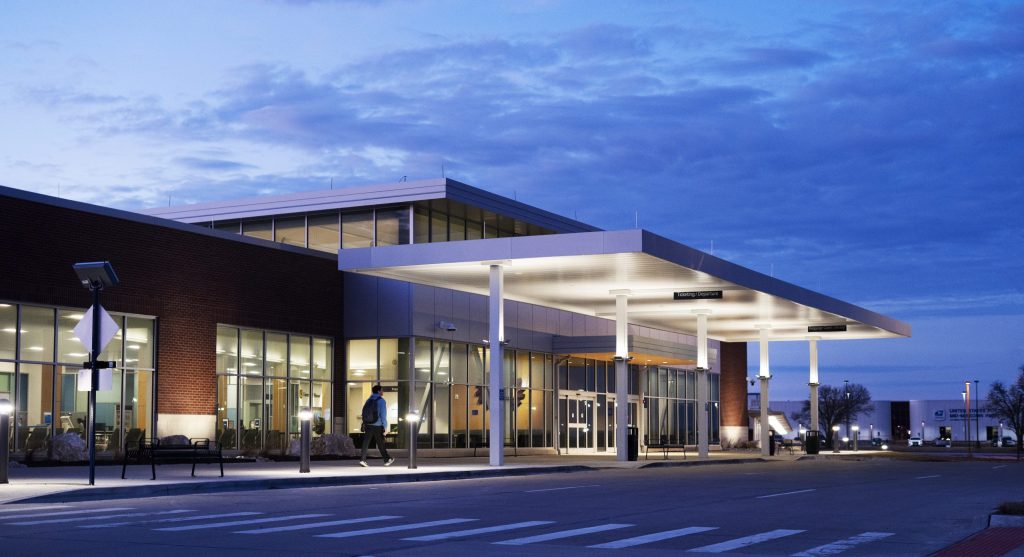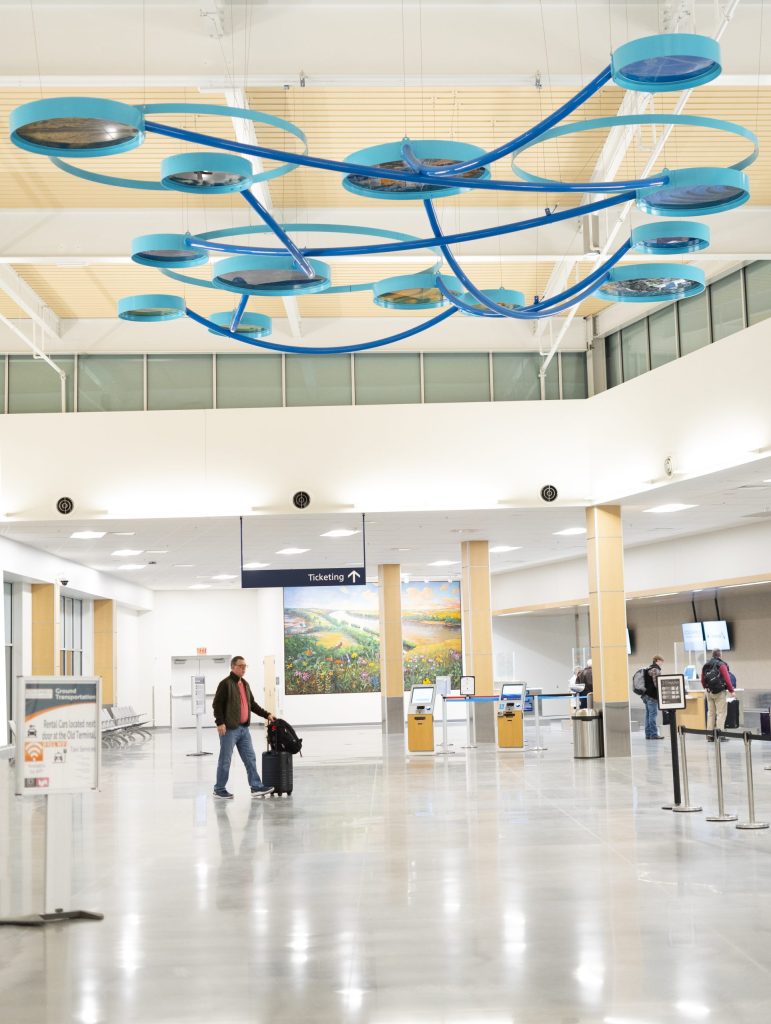Photos by Ava Kitzi
Here’s a travel tip for anyone who hasn’t been to the Columbia Regional Airport recently. It’s time to give it a second look and a second chance.
Since its official opening, a year and a half ago, the new terminal is proving itself a welcome upgrade that makes traveling more of a pleasure and less of a pain. Not only that, but the new terminal gives a giant boost to mid-Missouri’s image as a thriving community, making it a more inviting place for new businesses that are considering expanding to the area. Although COU has continually held its place among the four largest airports in Missouri — topped only by St. Louis, Kansas City and Springfield — the new terminal gives the region a Major League look.
When people talk about the airport to Columbia Mayor Barbara Buffaloe, they can’t hide their enthusiasm. “I hear people say, ‘Oh, we have a professional airport, now.’ Everyone appreciates its spaciousness and its new amenities. The airport is our welcome mat to Columbia, and when businesses are trying to recruit people, arriving at a real jet bridge makes a great first impression,” Buffaloe says.
It’s not just Columbia’s travelers who are benefiting from the new terminal while using it to begin or end their journeys. Surrounding communities are also benefiting. “It’s helping raise the awareness of opportunities throughout mid-Missouri,” Mayor Buffaloe continued. “It’s more convenient to fly in and out of Columbia if you live in this area or if you are doing business here.”
This spring and summer, flying out of COU will become an even more attractive travel option. On April 4, American Air will add a third daily flight to Chicago; and on June 5, it will add the fourth daily flight to Dallas-Fort Worth.
More options and a new terminal — Michael Parks, COU’s airport manager for the past seven years and longtime cheerleader for the airport, couldn’t be prouder of the facility and its growing impact on mid-Missourians. On a winter morning, before any of the American Air flights were scheduled for take-off, Parks made time to walk through the lobby and describe the features and artwork of the new terminal, as well as to reflect on the progress he’s seen in the 22 years that he has been affiliated with the airport. “When we started here, we had 19 passenger turboprop planes that would go to and from St. Louis and Kansas City.”
While turboprops were state of the art in their day, they were limited to flying slower at lower altitudes than jets, and they had a rougher time with bad weather. “Back then, we hoped that someday we’d see a commercial jet flying out of here. Now, you can’t even find a turboprop,” he says.
It wasn’t just the technology that changed over the years. So did the community’s support for the airport. “Mid-Missouri is 100 percent behind their airport, which is just one stop to a major hub. And from those hubs — Chicago or Dallas-Fort Worth — you can go anywhere in the world,” he says.
That community support brought about the $23 million project, which took two and a half years to complete. Gone are the days when passengers had to walk from the terminal, exposed to all kinds of weather and then climb a steep ramp to board their plane. Parks sums up the impression the old terminal made on visitors with a self-deprecating understatement. “It wasn’t glamorous.” Then he explains: “If you wanted to get people or businesses to relocate to mid- Missouri it wasn’t so enticing, getting off the apron and walking outdoors into those doublewide trailers. Now, our airport represents mid-Missouri well, the way our region really should be represented.”
Currently, the airport has three passenger bridges, but as the number of passengers increases, another will be added. But even with strong local support, the airport has to compete for airlines with cities throughout the nation. The city is making a team effort to increase the number of flights and airlines. “While we continue to invest in the relationships we have with airlines, our Office of Economic Development and Regional Economic Development Inc. are working hard to attract more airlines to Columbia,” Mayor Buffaloe says.
In 2019, before the pandemic devastated air travel and before United Airlines dropped out of 11 regional markets, including Columbia, about 270,000 people flew in or out of the airport. Last year, the numbers were headed back up, topping off at 200,000. Parks attributes the upward trend to the increase in aircraft size and a return to the new normal after the pandemic years. “We don’t have nearly as many 50-passenger jets coming in. Now we have mostly 70-passenger jets. No one really knows what the limit is when we have more flights. We’re going to see those numbers continue to increase,” he says.
Mayor Buffaloe shares the same optimistic look at the future. “You’re seeing regional air traffic increase, locally and nationwide,” she says. Confident of growth, she adds, “We are going to see an increase in destinations, perhaps in airlines interested in partnering with us. Although the pandemic set us back, we enjoy strong support from our businesses, from higher education and the local community.”
There’s plenty of room at the airport to handle future growth. The old terminal, tiny in comparison to the new terminal, was built in 1968 and remains standing a few yards north of the new one. At 52,000 square feet, the new terminal is more than three times the size of the one it replaced. And it’s not just the spaciousness that sets it apart from the old terminal. It has an entirely different feel. It’s stylish, airy and modern. Entering through its front doors, visitors walk beneath Denver artist David Grigg’s art installation, looping blue tubes connecting glass disks, designed to resemble airline route maps. Its graceful lines seem to float above the main lobby. On either side of the main entrance are a pair of circular sculpted pieces by local artist Chris Morrey, which he titled, Returning. The north wall of the lobby is covered by Jane Mudd’s colorful 17 x 10- foot mural of a Missouri River scene. The overall impression that the art makes is that this is more than just a functional space: with its high ceilings, gleaming floor and rows of windows that flood the lobby with natural light, it’s an inspiring setting, a place where people want to spend some time.
Like every other airport, the floorplan is divided into lobby areas open to the public, separated from secure areas consisting of waiting rooms and boarding gates, accessible to outgoing travelers only after going through the TSA area. The public areas include airline ticket counters, seating for visitors, a baggage carousel, bathrooms and an entrance into the enlarged TSA screening area. “We’re ADA- friendly and not just ADA-accessible,” says Parks. “Which is one of the things we’re most proud of. We have mothers’ (nursing) rooms in both the public and the secure side; family restrooms; and bathrooms without doors so there are no high-touch areas going in and out of them. We even have a sensory room on the secure side for people with sensory concerns who need a calm, quiet area. In addition, we have a service animal relief area on the secure side, complete with a red fire hydrant.”
Built for today’s travelers who depend on their smartphones, most of the seats on the secure side have built-in charging ports. For those needing an area to spread out their work, several desk-sized working platforms are available. On the downside, visitors wanting a snack before their flights have fewer options than can be found in major airports. For the time being, vending machines, free samples of Quaker rice cakes or complementary coffee provided by the airport are the only choices. There’s space designated for a food vendor, and Parks hopes to add that option later this spring. A contract with the Jackson Brothers of North, LLC has been signed and construction will begin on this area this winter. In the meantime, it’s not much of an inconvenience, considering that COU is either the beginning or end of journeys, only 15 minutes from the comforts of home. At the major hubs, where travelers may be spending long and hungry hours between flights, full meal options are a necessity. Still, a nice airport restaurant would be welcomed by the community.
Beyond the new terminal, there’s a lot more going on that’s improving travel experiences for flyers. A few years ago, the airport’s main runway was extended by about 1,000 feet. While pilots may like the extra length, it’s travelers who benefit the most. “It enhances the ability to bring in larger aircrafts and improves their ability to operate in inclement weather,” says Parks. “It means fewer delays as well as fewer cancellations.”
Another less visible development is also helping to reduce flight delays. Before last August, if something went wrong with an airplane, it could takea couple hours for qualified airplane mechanics to get to COU from either Springfield, Dallas or Chicago. But that travel time and the delays or missed connecting flights it caused is now a thing of the past. An arrangement between Envoy Air (the local subsidiary of American Air) and Airline Maintenance Service (AMS) a Nashville-based company, ensures that parts and a mechanic will be on-hand in Columbia 24/7. President of AMS Corey Gillard says, “Having qualified mechanics with parts available won’t solve all issues but can certainly mitigate the more common ones, keeping the aircraft flying on time.”
Part of the arrangement with AMS ensures that routine maintenance on the planes is done overnight. It’s more convenient to service these planes in Columbia than at the major hubs, where it’s more difficult to find hangar space. “Having that maintenance done doesn’t so much impact the Columbia flyer,” Gillard says. “But it impacts the ability of Envoy to keep more aircraft in the air.”
Because of pilot shortages nationwide, it’s essential that airlines make efficient use of every plane in their fleet. In the years ahead, there will certainly be more pilots who live and work out of mid- Missouri than there are today. Moberly Area Community College (MACC) has leased the old airport terminal and will convert the main space into a classroom, where future commercial pilots will be trained at COU. “We’ll be offering an associate of applied science degree in aviation flight technology training for pilots,” says Todd Martin,
vice president of instruction at MACC. Between now and 2025, the community college will contract out the renovations and complete its process for getting approval for the program from Missouri’s Coordinating Board for Higher Education and regional accreditation from the Higher Learning Commission. Based on enrollment demands at Ozark Technical College, the only other community college offering a similar program, Martin expects about 25 students to form the first cohort of new pilots. “The students will graduate from the program with a private pilot’s license, an instrument rating and a commercial pilot’s license. They will also have an option to take an elective course to get certified as a qualified flight instructor as well,” he says.
As Parks reached the end of his tour and interview about the airport, he made one last sales pitch about the new facility. “I always say that once somebody has used the airport, they realize how easy it is. If there’s any additional cost to fly out of Columbia, it’s offset with free parking or saving the price of a hotel if you have a morning flight out of St. Louis or Kansas City. The ease of going through security here and of leaving your house and being at the airport in 15 minutes is fantastic. We’re pulling in a lot more people who are starting to use the airport again,” he says.









